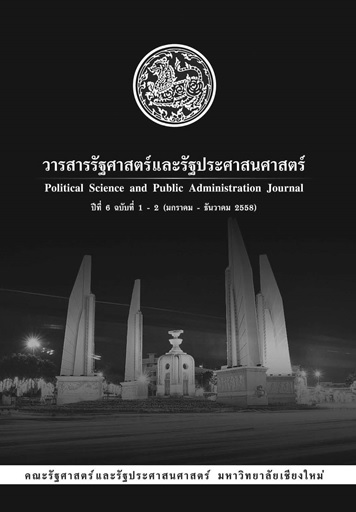The Expansion Results Project to follow up the solutions of Smog Crisis, Chiang Mai Province, B.E.2555
Main Article Content
Abstract
The study on “The Expansion Results Project to follow up the solutions of Smog Crisis, Chiangmai Province, B.E.2555 aimed to 1) follow up the progressive results of alternative choices in the areas which was chosen to be the network of local learning center for smog solution. The project focused to follow up two alternative choices: the first choice was the fund for smog solution and the second choice was wood chipper machines which operated in 18 districts in Chiang Mai Province and 2) to study the development of smog solution in those areas.
The study found that there were various measures to solve smog crisis in 18 districts, which were: 1) to establish ad hoc center for smog solution 2) to manage wildfire by conserving and controlling burn, including extinguishment 3) to declare wildfire control areas 4) to demolish branches, leaves and agricultural waste 5) to give knowledge about burn and smog problems 6) to organize the prevention and adjustment committees and 7) to enforce the law for smog control and solution, for example, to declare local legislation for smog control and solution broadly, hence, burn and smog problems decreased in 11 districts, for example, in Sarapee District, Maetang District and Chaiprakarn District and 7 districts remained the burn problem which was caused smog problems, for example, Chiangdao District, Maejam District and Omkoi District.
According to the fund for smog solution, the study indicated that the sampling groups organized the committees and usefully managed the fund in different ways such as making fertilizer, doing activities for smog control and smog solution and providing garbage disposal. However, there were 2 areas, Fund of Longkhod Subdistrict Administrative Organization, Phrao District and Donkaew Subdistrict Administrative Organization, Maerim District, which have not used the fund usefully yet.
The study also showed that the sampling groups in 12 districts used wood chipper machines broadly as they used them for shredding branches leaves and agricultural wastes for making fertilizer but there were some restrictions as it worked slowly, wasted the fuel oil, needed 2-3 people to work which was not convenient and also machines were difficult to move in order to working off-site.
Article Details
- เนื้อหาและข้อมูลที่ลงตีพิมพ์ในวารสารรัฐศาสตร์และรัฐประศาสนศาสตร์ถือเป็นข้อคิดเห็นและความรับผิดชอบของผู้เขียนบทความโดยตรง ซึ่งกองบรรณาธิการวารสารรัฐศาสตร์และรัฐประศาสนศาสตร์ ไม่จำเป็นต้องเห็นด้วย หรือร่วมรับผิดชอบใดๆ
- บทความและข้อมูล ที่ได้รับการตีพิมพ์ในวารสารรัฐศาสตร์และรัฐประศาสนศาสตร์ ถือเป็นลิขสิทธิ์ของวารสาร หากบุคคลหรือหน่วยงานใดต้องการนำข้อมูลไปใช้ประโยชน์ในทางวิชาการ ขอให้อ้างอิงแหล่งที่มาด้วย
References
ทัศนียา บริพิศ. (2552). การกำกับติดตามและการประเมินผล.กรุงเทพฯ: มหาวิทยาลัยราชภัฏธนบุรี.
ทิพวรรณ ประภามณฑล และคณะ. (2554).มลพิษทางอากาศและหมอกควันในภาคเหนือตอนบนของประเทศไทย (Air Pollution and Smog in Upper Northern Thailand). เชียงใหม่:สถาบันวิจัยวิทยาศาสตร์สุขภาพ มหาวิทยาลัยเชียงใหม่.
ไพรัช ตระการศิรินนท์ และคณะ. (2553) โครงการสร้างความเข้มแข็งแก่ชุมชนในการแก้ไขปัญหาวิกฤติหมอกควันกิจกรรมการพัฒนาชุมชนเป็นแหล่งเรียนรู้การแก้ไขปัญหาหมอกควัน. เชียงใหม่: คณะรัฐศาสตร์และรัฐประศาสนศาสตร์มหาวิทยาลัยเชียงใหม่.
ไพรัช ตระการศิรินนท์ และคณะ. (2553) โครงการสร้างความเข้มแข็งแก่ชุมชนในการแก้ไขปัญหาวิกฤติหมอกควันกิจกรรมศึกษาวิจัยทางเลือกในการแก้ไขปัญหาหมอกควันและการพัฒนาเครือข่ายการเฝ้าระวัง. เชียงใหม่: คณะรัฐศาสตร์และรัฐประศาสนศาสตร์ มหาวิทยาลัยเชียงใหม่.
วิจารย์ สิมาฉายา. (2554.). มลพิษจากหมอกควันในพื้นที่ภาคเหนือ: ปัญหาและแนวทาง. เอกสารสำหรับการสัมนา“วิกฤตโลกร้อน มลพิษหมอกควัน มหันตภัยใกล้ตัว” ของคณะกรรมาธิการทรัพยากรธรรมาชาติและสิ่งแวดล้อม วุฒิสภา (11 กุมภาพันธ์ 2554 ณ จังหวัดเชียงใหม่).
สถาบันอุดมศึกษาไทยเพื่อพัฒนานโยบายสารธารณะที่ดี. คู่มือใช้ข้อมูลหมอกควันและไฟป่า.สถาบันศึกษานโยบายสารธารณะมหาวิทยาลัยเชียงใหม่, มิถุนายน 2553
อภิรัชศักดิ์ รัชนีวงศ์. (2552). การประเมินผลพัฒนาการงานยุติธรรมชุมชน กระทรวงยุติธรรม. กรุงเทพฯ: สำนักนโยบายและยุทธศาสตร์ สำนักงานปลัดกระทรวงยุติธรรม.

